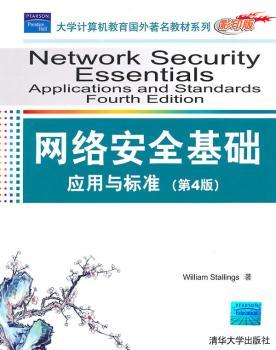内容简介
《网络安全基础:应用与标准(第4版)(影印版)》由作者William Stallillgs编写,以当今网络安全的实际解决方案为基础,既简明扼要,又全面系统地介绍了网络安全的主要内容,包括基本原理、重要技术、主要方法和重要的工业标准等。全书共包含11章。除第1章引言外,其余各章分为三大部分叙述:第一部分是密码学,重点介绍分组密码、流密码、消息认证码、安全杂凑函数、公钥密码和数字签名等的基本原理、主要方法和重要应用场景等,并简要介绍了几种常用的典型算法,包括DES算法、AES算法、RC4算法和RSA算法等;第二部分是网络安全应用,简要介绍了传输层安全中的SSL/TLS协议、无线局域网安全及WAP协议、电子邮件安全与PGP与S/MIME协议;IP层安全与IPsec协议等。第三部分是系统安全,简要介绍了入侵检测与口令管理、恶意软件与防火墙等。 《网络安全基础:应用与标准(第4版)(影印版)》以和实用的网络安全知识为主题,采用深入浅出的叙述手法,每章末尾还给出一定的读物和思考练习题。因此,《网络安全基础:应用与标准(第4版)(影印版)》既是高等学校网络安全基础课程的好教材,也是工程技术人员和网络爱好者了解网络安全基本概貌的好读物。
目录
Preface ix
about the Author xiv
Chapter 1 Introduction 1
1.1 Computer Security Concepts 3
1.2 The OSI Security Architecture 8
1.3 Security Attacks 9
1.4 Security Services 13
1.5 Security Mechanisms 16
1.6 A Model for Network Security 19
1.7 Standards 21
1.8 Outline of This Book 21
1.9 Recommended Reading 22
1.10 Internet and Web Resources 23
1.11 Key Terms, Review Questions, and Problems 25
PART ONE CRYPTOGRAPHY 27
Chapter 2 Symmetric Encryption and Message Confidentiality 27
2.1 Symmetric Encryption Principles 28
2.2 Symmetric Block Encryption Algorithms 34
2.3 Random and Pseudorandom Numbers 42
2.4 Stream Ciphers and RC4 45
2.5 Cipher Block Modes of Operation 50
2.6 Recommended Reading andWeb Sites 55
2.7 Key Terms, Review Questions, and Problems 56
Chapter 3 Public-Key Cryptography and Message Authentication 61
3.1 Approaches to Message Authentication 62
3.2 Secure Hash Functions 67
3.3 Message Authentication Codes 73
3.4 Public-Key Cryptography Principles 79
3.5 Public-Key Cryptography Algorithms 83
3.6 Digital Signatures 90
3.7 Recommended Reading and Web Sites 90
3.8 Key Terms, Review Questions, and Problems 91
PART TWO NETWORK SECURITY APPLICATIONS 97
Chapter 4 Key Distribution and User Authentication 97
4.1 Symmetric Key Distribution Using Symmetric Encryption 98
4.2 Kerberos 99
4.3 Key Distribution Using Asymmetric Encryption 114
4.4 X.509 Certificates 116
4.5 Public-Key Infrastructure 124
4.6 Federated Identity Management 126
4.7 Recommended Reading and Web Sites 132
4.8 Key Terms, Review Questions, and Problems 133
Chapter 5 Transport-Level Security 139
5.1 Web Security Considerations 140
5.2 Secure Socket Layer and Transport Layer Security 143
5.3 Transport Layer Security 156
5.4 HTTPS 160
5.5 Secure Shell (SSH) 162
5.6 Recommended Reading and Web Sites 173
5.7 KeyTerms, Review Questions, and Problems 173
Chapter 6 Wireless Network Security 175
6.1 IEEE 802.11 Wireless LAN Overview 177
6.2 IEEE 802.11i Wireless LAN Security 183
6.3 Wireless Application Protocol Overview 197
6.4 Wireless Transport Layer Security 204
6.5 WAP End-to-End Security 214
6.6 Recommended Reading andWeb Sites 217
6.7 Key Terms, Review Questions, and Problems 218
Chapter 7 Electronic Mail Security 221
7.1 Pretty Good Privacy 222
7.2 S/MIME 241
7.3 DomainKeys Identified Mail 257
7.4 Recommended Reading and Web Sites 264
7.5 Key Terms, Review Questions, and Problems 265
Appendix 7A Radix-64 Conversion 266
Chapter 8 IP Security 269
8.1 IP Security Overview 270
8.2 IP Security Policy 276
8.3 Encapsulating Security Payload 281
8.4 Combining Security Associations 288
8.5 Internet Key Exchange 292
8.6 Cryptographic Suites 301
8.7 Recommended Reading and Web Sites 3
摘要与插图
3DES has two attractions that assure its widespread use over the next few years. First, with its 168-bit key length, it overcomes the vulnerability to brute-force attack of DEA. Second, the underlying encryption algorithm in 3DES is the same as in DEA. This algorithm has been subjected to more scrutiny than any other encryption algorithm over a longer period of time, and no effective cryptanalytic attack based on the algorithm rather than brute force has been found. Accordingly, there is a high level of confidence that 3DES is very resistant to cryptanalysis. If security were the only consideration, then 3DES would be an appropriate choice for a standardized encryption algorithm for decades to come.The principal drawback of 3DES is that the algorithm is relatively sluggish in software. The original DEA was designed for mid-1970s hardware implementation and does not produce efficient software code. 3DES, which has three times as many rounds as DEA, is correspondingly slower. A secondary drawback is that both DEA and 3DES use a 64-bit block size. For reasons of both efficiency and security, a larger lock size is desirable.
Because of these drawbacks, 3DES is not a reasonable candidate for long-term se. As a replacement, NIST in 1997 issued a call for proposals for a new Advanced ncryption Standard (AES), which should have a security strength equal to or better han 3DES and significantly improved efficiency. In addition to these general equirements, NIST specified that AES must be a symmetric block cipher with a block length of 128 bits and support for key lengths of 128, 192, and 256 bits. evaluation criteria included security, computational efficiency, memory requirements, hardware and software suitability, and flexibility.




 VIP会员
VIP会员